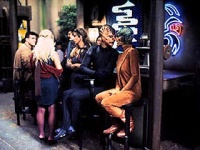Star Trek: An Introduction/The Star Trek future
| Star Trek: An Introduction |
|---|
What's life like in the future?Star Trek's future is defined by technological advances far beyond our own, and diversity of intelligent species which interact on a daily basis. One of the most important pieces of technology, which makes the story of Star Trek possible, is the "warp" engine – a starship engine that allows the ship to move many times faster than the speed of light.
A Typical Day in the 24th CenturyTo demonstrate, we will take a standard day in the life of Angelica, a skilled writer of fantasy dramas. She gets up at 5 in the morning and replicates her breakfast of ham and eggs. This materialization is immediate, and she can recycle the dish just by putting it in the replicator. That said, she normally opts to get food at a nearby café - the replicator just doesn’t have that fresh feeling. Today, though, she has an important client to meet off the planet Axanar, and the regular shuttle between it and Earth departs from the Spacedock in 2 hours. She hurriedly puts her PADD tablet with all her writings in her case along with the cube containing her latest drama. She heads to the transport station and beams up to the commercial spacedock orbiting Earth. Standing in the transporter, she can't even feel it as her body and possessions are converted to energy and, in a twinkle of light, sent up to the orbital station. As people enter the station, Angelica follows the crowd to the main boarding area. There’s no security gate or long lines of people waiting for their chance to be scanned - the sensors within the station scan all that enter, eliminating the need for overt security. She boards the starship, which heads off to Axanar at speeds faster than the speed of light. As she boards, she looks at the arrival board and makes a quick call to her editor on Axanar, notifying them that she will be running a little late.  An Intrepid class starship As the shuttle leaves the spacedock she spots the USS Dauntless, a starship assigned to patrol the area. There have been reports of a pirate gang attempting to prey on commercial starships in this area, but with the aid of the Dauntless's patrol, the shuttle safely arrives on Axanar. The small orange sun has just reached the horizon, brilliantly lighting up the red oceans of Axanar as the shuttle lands in the main field of it’s capital city. Taking the magnetic transit train over to the headquarters of the publishing company she works with, Angelica begins her presentation in a large meeting room by popping her cube into a console, transforming it into a old and decaying forest in a moment. This room is a hologrid - a room made up of light and forcefields that with a single command can take on the appearance of nearly anything. This allows her to create one of the major settings of the drama, with the heroine as an interactive guide, demonstrating the project. A few of the producers are enchanted by the heroine, and the rest approve of the drama, intending to release it for wide consumption across hundreds of star systems. She doesn’t receive any compensation besides the acclaim of those who will enjoy the drama, for the economy in the Federation doesn’t work on money anymore. However, it doesn’t cost her anything to produce, either. The trip home to Earth is as uneventful as the passage to Axanar. To celebrate the new contract, she goes to a well-known Cajun restaurant in New Orleans with a friend from Nagoya, who programs self-sufficient mining machines for use in asteroid belts. Angelica and Keiko often meet for a meal if both are on Earth, since the transporter stations span the globe, making travel almost anywhere on the planet easy and nearly instant. She beams back at the end of a nice meal, and turns in early, after starting some research into the myths of a long dead planet some 100 light years distant. She needs to start work on her next drama, after all. Imagine, though, that you are an officer on the Dauntless, the starship patrolling the lanes. Or maybe you’re the officer who built or designed the Dauntless, or the engineer who built the transporter network that connects Earth. Or maybe you’re a member of Starfleet’s Engineering Corps, who maintain and construct the network that allows for near instantaneous conversations over hundreds of light years. Those officers are Starfleet Officers. |
| Ensigns Orientation |
|---|












